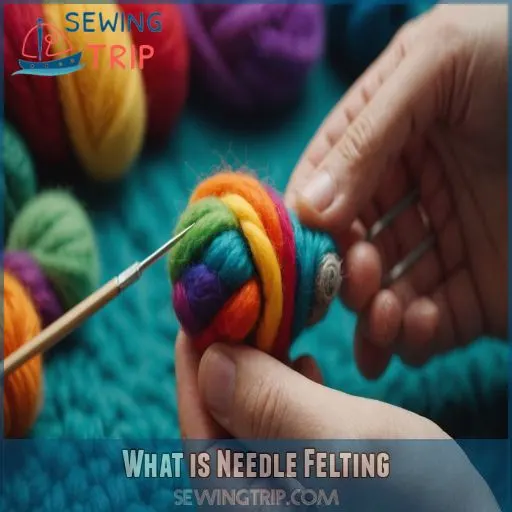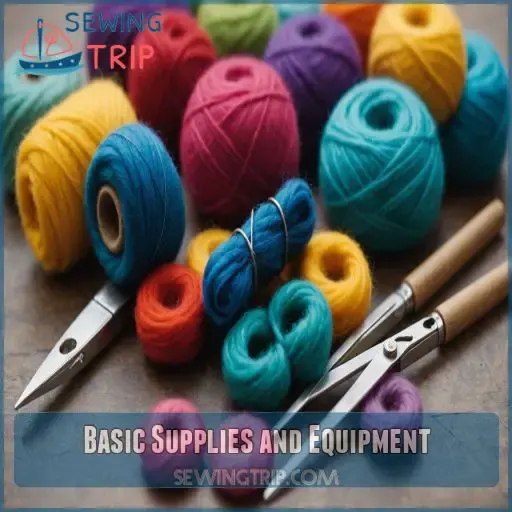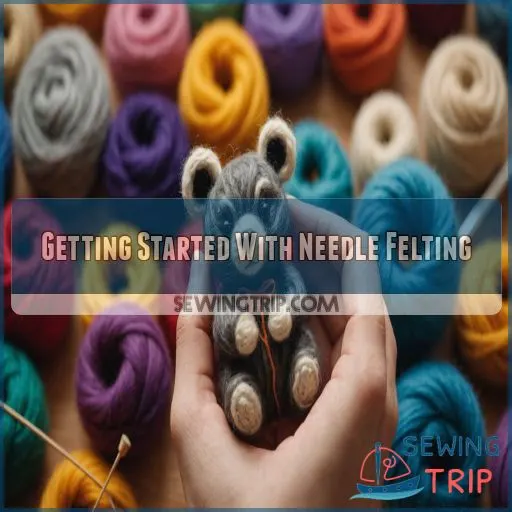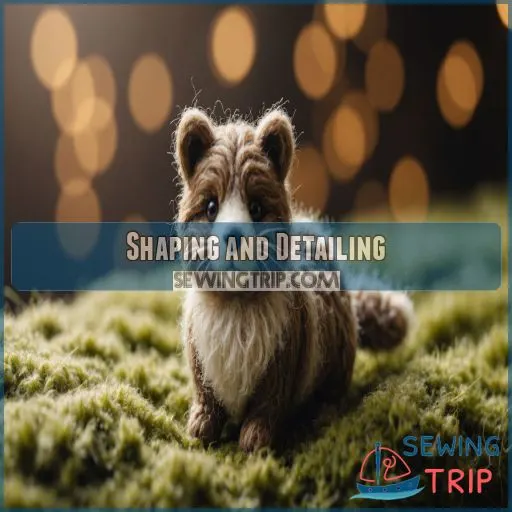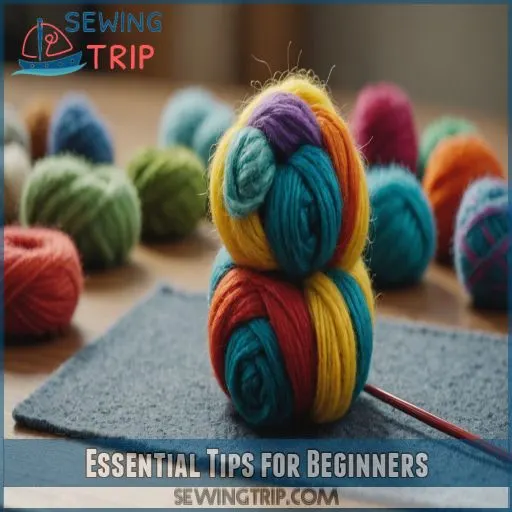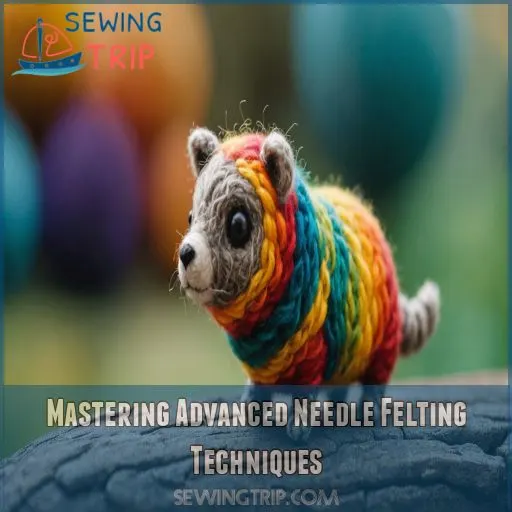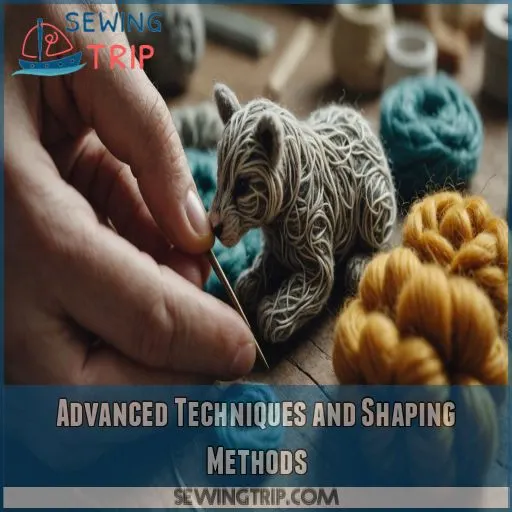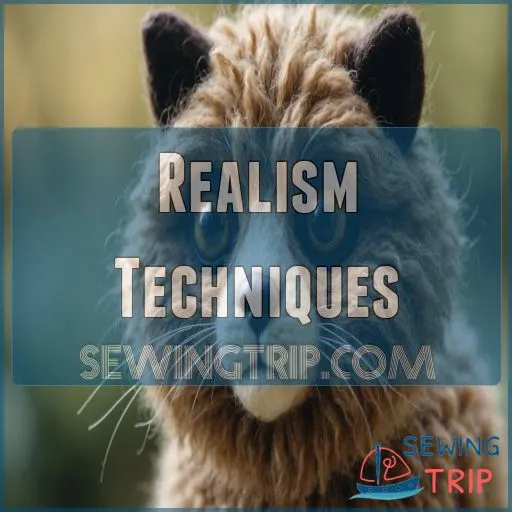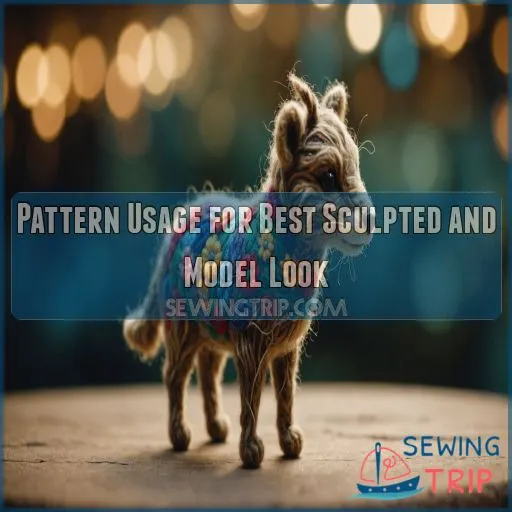This site is supported by our readers. We may earn a commission, at no cost to you, if you purchase through links.
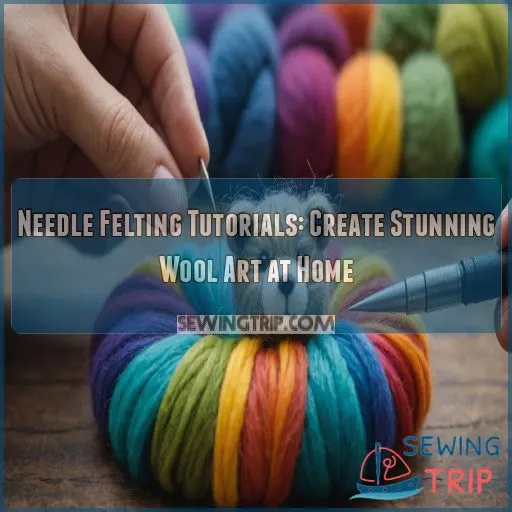 Needle felting is your doorway to magic, where fluffy wool becomes striking sculptures through enchanting jabs of tiny, barbed needles.
Needle felting is your doorway to magic, where fluffy wool becomes striking sculptures through enchanting jabs of tiny, barbed needles.
With just a felting mat and some lovely merino or alpaca wool, you’ll soon shape basic forms like balls and cylinders.
Watch those fingers as you master poking and spiraling wool to life, creating animals and whimsical creatures that amaze.
You’re not just crafting; you’re creating a menagerie of wonders with each careful poke.
As you start, imagine colors dancing from your palette to the wool, weaving tales in texture.
Ready to craft lifelike art? Let’s uncover the magic!
Table Of Contents
- Key Takeaways
- What is Needle Felting
- Basic Supplies and Equipment
- Getting Started With Needle Felting
- Shaping and Detailing
- Essential Tips for Beginners
- Mastering Advanced Needle Felting Techniques
- Advanced Techniques and Shaping Methods
- Realism Techniques
- Pattern Usage for Best Sculpted and Model Look
- Frequently Asked Questions (FAQs)
- Conclusion
Key Takeaways
- Dive into needle felting, where you’re the magician transforming fluffy wool into striking sculptures with just a needle. It’s like turning clouds into creatures, one delightful poke at a time!
- Gather your trusty tools—those sharp little barbed needles, vibrant wool, and a cozy felting mat—and you’ll soon be a maestro crafting adorable animals or mystical figures. Think of your supplies as the magical toolkit that turns imagination into tangible art.
- Start with simple shapes like balls or cylinders and let your creativity spiral from there. Remember, a careful jab here and a twist there can bring wool to life, much like convincing a cat off a comfy couch—patience and persistence are key!
- As you master the craft, don’t shy away from adding color and texture. Like painting a sunset with wool, blending shades will bring your creations to life with whimsical detail. Get ready for a journey where each fiber, like a thread in your storybook, weaves a tale of woolly wonder!
What is Needle Felting
needle felting transforms fluffy wool into firm sculptures using small, barbed needles—it’s like magic, minus the wand!
You’ll soon get hooked on this quirky craft where you’ll trade traditional paints for soft fiber, creating adorable critters and charming decorations with every stab.
History and Development of Needle Felting
Needle felting has a rich history dating back centuries, with early felting methods used in various cultures around the world.
From humble beginnings, the craft has evolved, with modern needle felting tools and techniques allowing artists to create stunning, lifelike sculptures.
Explore this amazing art form and discover your creative potential!
Techniques Used in Needle Felting
Just as needle felting has woven its way through history, today’s techniques turn wool into art. Master these basics and work magic:
- Wool Blending: Create unique colors and textures. Like mixing paints, but fluffier.
- Texture Creation: Mimic nature’s finest with every poke.
- Shaping Techniques: Sculpt freehand, like a modern Michelangelo—minus the marble dust.
Essential Tools for Needle Felting
You’ve grasped the techniques, now let’s chat about needle felting supplies.
Start with a felting kit that includes various felting needle sizes, each offering unique sculpting magic.
Grab roving wool and a sturdy felting mat to protect your table—and those fingers!
Basic Supplies and Equipment
Start your needle felting journey by gathering essential supplies like vibrant wool, various barbed needles, protective gear, and trusty felting mats to let your creativity flow without any prickly surprises. Learn more about fabric properties to choose the perfect wool for your project.
Imagine these tools as your crafty sidekicks, helping you transform fluffy wool into eye-catching sculptures with ease and finesse!
Choosing the Right Wool
Choosing the right wool is key to needle felting success. Opt for soft, high-quality fibers like merino or alpaca. Experiment with blending different colors and textures to create unique effects. Consider cost, availability, and how the wool handles – some are easier to work with than others.
- Merino Wool
- Alpaca Wool
- Wool Blends
- Wool Quality and Cost
Different Types of Felting Needles
Think of felting needles like a kitchen full of different knives, each with its purpose.
Barbed needles come in various sizes and shapes, essential for needle felting projects.
Use fine needles for details, coarse ones to bulk up, and keep them safe!
Felting Mats and Protective Gear
When you’re needle felting shapes, choosing the right mat types is as important as needle choice, like having a comfy couch for crafting.
Prioritize safety first! Use a felting surface that protects fingers and lasts longer.
Protective gear helps you avoid pesky pinpricks.
Working With Scissors and Other Accessories
You’ve got your felting mat, now grab those scissors!
Scissors safety is numero uno.
Trim wool fibers with precision for clean edges.
Organize your tools like a pro; it’s felting symphony time.
Accessorize your needle felting art with style, flair, and needle felting inspiration!
Getting Started With Needle Felting
Ready to jump into the wonderful world of needle felting?
Start your creative journey with our step-by-step guide that covers the essential stitches, techniques, and shaping methods to transform fluffy wool into stunning 3D sculptures.
Get ready to poke, prod, and shape your way to needle felting mastery!
Step-by-Step Instructions for Beginners
Now that you’ve gathered your supplies, let’s kickstart your needle felting journey with simple projects!
Choosing the right wool and needles helps make sure you have a smooth start.
Begin by shaping basic forms like balls or cylinders on your felting mat.
Use careful, repetitive needle jabs, but watch those fingers!
Needle felting can be quite meditative—just guard against rogue needles as you sculpt masterpieces.
Basic Stitches and Techniques
You’ve started your needle felting journey, and it’s time to roll up your sleeves. Basic needle felting stitches are your new best friend.
Create magic by:
- Spiraling wool into a felted ball
- Layering wool for smooth surfaces
- Using a needle brush for details
- Shaping felted animals with ease
- Crafting with a tiny brush
Ready, steady, stab!
Shaping and Smoothing With Needles
You’ve mastered basic stitches, and you might wonder, “How do I smooth this fluffy creature?” You can use backstitching techniques to secure your seams and prevent unraveling
Picture needle felting techniques as coaxing a grumpy cat—patience is key.
Shape with intention, teasing the wool into smooth surfaces.
Play a game of stab-and-twist to fine-tune wool where needed.
Your needle felted animals will thank you with delightful expressions!
Shaping and Detailing
Learn the secrets of shaping and detailing your needle felted creations!
From sculpting basic forms to adding intricate textures and lifelike features, this section will guide you through the techniques that transform plain wool into amazing works of art.
Creating Basic Shapes for Needle Felting
Mastering basic shapes is the foundation of needle felting.
Roll wool into shapes like balls, eggs, or cylinders—trust me, they aren’t just breakfast items!
Stab into the fluffy felt with delight, shaping a masterpiece in the making.
Needle felting workshops, classes, or online resources are perfect for unraveling the secrets of joining these shapes into charming artworks.
Advanced Shaping Techniques for 3D Sculptures
Now that you’ve mastered basic shapes, it’s time to explore advanced techniques in sculpting animals.
Imagine you’re sculpting a majestic wool lion. Use wire armature for stability, enabling lifelike poses.
Experiment with manipulating wool to achieve a smooth finish and realistic fur textures.
Add intricate details inspired by needle felting books, crafting sculptures that appear ready to roar to life!
Adding Curls and Curves With Wire and Yarn
Curving yarn and wire in needle felting is like shaping magic.
Choose the right wire gauge for flexibility, creating armatures to give life to your sculptures.
Experiment with yarn types—soft curls or thick, sturdy textures.
Use bend techniques to shape loops and spirals, achieving elegance or whimsy.
Add these to your needle felting equipment collection for super smoothness.
Essential Tips for Beginners
As a beginner, you’ll be amazed at how your nimble fingers and a little poking, spiraling, and shaping can transform simple wool fibers into cool textured creations. You’ll discover the soft, itch-free feel of alpaca fibers https://sewingtrip.com/what-does-alpaca-feel-like/ and experience the joy of making beautiful things with your own hands.
Learn the secrets to crafting realistic fur and removing pesky imperfections with expert tips that will have you needle felting like a pro in no time.
Using Hands and Fingers in Needle Felting
To begin with needle felting, make sure you’ve got fingertip control and the right hand position—it’s really important for your masterpiece!
Balance finger pressure to reduce hand fatigue.
Use grip techniques to stay relaxed, like holding a baby bird—don’t crush it!
Poking, Spiraling, and Shaping Wool Fibers
Mastering needle felting techniques starts with poking wool fibers like a sculptor chiseling marble, much like using a thimble to protect your fingertip while hand sewing. Spiral your needle with flair, forming delightful twists.
Embrace your inner artist and shape wool sculptures into whimsical wonders.
Top Tricks for Creating Realistic Fur Textures
Ready to create realistic fur? Layering wool is your secret weapon to master texture and depth.
Blend colors skillfully, using your tools to tease out lifelike patterns.
Removing Imperfections With Brushing Tools
Don’t let those pesky imperfections ruin your masterpiece!
Brush away stray fibers and smooth out bumpy surfaces with a trusty felting brush.
Glide it gently over your wool creations, coaxing out a flawless, velvety finish that’ll have everyone swooning.
Embrace the power of brushing – your felted friends deserve nothing less!
Mastering Advanced Needle Felting Techniques
You’re about to discover the magic of advanced needle felting, where wires give your wooly sculptures their own backbone and personality!
Don’t shy away from adding a splash of color and texture; your creations will turn heads faster than a runaway sheep.
Incorporating Wires for Enhanced Stability
Wire can make your wool sculptures come to life. Let’s take a closer look at wire types and armature creation for added pose flexibility.
- Wire Bending: Craft limbs or tails by twisting wires into shape.
- Wire Insertion: Secure wires inside wool for stability.
- Pose Flexibility: Shift wires to create lively, dynamic poses.
Get ready for wire-wielding fun!
Applying Multicolored Patterns for Extra Details
Ever wonder why some felted creations pop with charm? It’s all about color blending and gradient effects!
Use vibrant wool to craft enchanting patterns.
Dabble with color theory and pattern inspiration to breathe new life into your wool sculptures.
Go on, let your imagination run wild!
Texturizing Surfaces for Texture Variety
Explore your creativity by texturizing the surfaces of your needle-felted creations!
Experiment with blending different wool fibers for a one-of-a-kind look.
Utilize specialized tools like wire brushes or carding combs to add depth and dimension.
The possibilities are endless when you embrace the natural textures of wool.
Get ready to wow with your textured masterpieces!
Advanced Techniques and Shaping Methods
Explore the vibrant world of advanced needle felting, where you can blend multiple colors to add whimsy and life to your wool sculptures.
With a few creative twists, you’ll master intertwining colors like a pro, turning simple fibers into stunning art pieces that’ll impress even your cat.
Multi-Colored Roving Patterns for Whimsy and Detail
Expanding your needle felting skills? Grab your roving wool and let’s play with some color blending techniques!
You’ll be creating whimsical animal designs and adding detailed character features that capture hearts.
Imagine using roving pattern inspiration to craft a unicorn with a mane that goes from blue to pink using stunning color gradient effects.
It’s like painting with wool, and the sky’s the limit. Remember, a splash of color adds that personality, so don’t be shy! Explore fun patterns and watch as your wool sculptures spring to life with vibrant charm and unique stories.
Intertwining or Integrating Several Color Designs
After exploring multi-colored roving patterns, let’s get adventurous with color blending! Think of your wool as a painter’s palette.
You’ll layer wool shades, gently poking and spiraling them together for mesmerizing gradient effects. Imagine a sunset captured in fiber—smooth color shifts that’ll have your project wowing everyone.
Start with light pressure, like convincing a cat off the couch, then shape your pattern layering. Use multi-color textures for lifelike detail.
Integrating diverse colors adds whimsy and depth. It’s not just crafting; it’s painting your wool sculptures with vibrant life, making every fiber count!
Realism Techniques
As you’ve mastered the basics of needle felting, it’s time to move into the world of realism.
Crafting lifelike eyes, capturing the nuances of fur, and blending textures seamlessly – these are the hallmarks of true artistry.
Shadows and highlights will breathe life into your creations, while strategic blending will make sure a seamless shift between colors and forms.
Embrace the challenge, my friend, and let your needle dance across the wool, weaving together the intricate details that will captivate your audience. The path to realism awaits.
Pattern Usage for Best Sculpted and Model Look
Going for realistic effects, pattern inspiration becomes your needle-felted masterpiece’s secret sauce. Mix and match colors like an artist at the palette, ensuring color blending and precise texture variations.
Picture yourself as a sculptor; aim for anatomical accuracy, capturing realistic fur with careful pokes and spirals.
Want a more dynamic creature? Focus on details and let pattern play guide your every stab. It’s like shaping a tiny woolen world, one jab at a time, with your imagination leading the charge.
Frequently Asked Questions (FAQs)
How to do needle felting for beginners?
Get started with needle felting by grabbing a felting needle, wool, and a foam block.
Stab the wool repeatedly to shape it like clay.
Keep at it, and soon you’ll sculpt wooly wonders with amazing detail.
Is needle felting easy?
Needle felting‘s a breeze once you get the hang of those barbed needles tangling wool fibers into amazing shapes.
It’s as straightforward as pie, so jump in, have fun, and watch your skills snowball!
Is needle felting a cheap hobby?
Think of needle felting as sculpting with wool—it’s affordable.
Starter kits won’t break the bank, and you’ll find raw materials cost pennies compared to other crafts.
Grab a kit, and explore your creativity economically!
How to avoid holes in needle felting?
You can avoid pesky holes in your needle felting by taking your time, applying even pressure, and using the right needle size for your project. Consider the care instructions for the yarn, such as hand wash or machine wash, and the fiber contents’ suitability for the project.
Don’t be afraid to re-felt areas if needed – it’s all part of the creative process!
How do I connect different parts of a needle felted project?
To connect parts, leave loose fibers at joints, overlapping them.
Stab with the felting needle vigorously like you’re jousting in a wooly battle!
Use wire armatures for added strength, ensuring your creation holds together like a pro.
What is the difference between needle felting and wet felting?
Needle felting uses dry, barbed needles to tangle wool fibers through repeated stabbing, like a needle dance.
Wet felting combines wool, water, and soap, using agitation to bond fibers, like a wooly car wash.
How many types of felting needles are commonly used?
Get started with needle felting with four main needle types at your fingertips: coarse, medium, fine, and reverse.
Each serves a unique purpose, shaping, smoothing, or adding texture, bringing your wool creations to life with flair.
How do I achieve a smooth finish on my needle felted creations?
Achieving a silky smooth finish takes patience, my friend.
Gently layer the wool, stabbing with intention, and you’ll soon have a creation that’ll have folks marveling at your felting finesse.
Consistency is key – trust the process, and the magic will unfold.
How much wool do I need for a specific needle felting project?
It depends on your project size.
For a small sculpture like a bird, use around 1 oz of wool.
Think of doubling or tripling that for larger projects.
It’s like baking—start with what you need!
Conclusion
Imagine a journey where every jab of the needle reveals a new world, like a sculptor with a wand crafting woolly wonders.
With the magic of tutorial needle felting, you’ve learned to mold the ordinary into extraordinary shapes, breathing life into fibers.
You’ll now wander through endless creative avenues, armed with skills and a fervor for felting.
Transform your wool into artful companions, and remember, each creation is uniquely yours—part of a delightful tapestry you’ve envisioned.

